The Pitching
Mechanic
November 2006
Real-Time Illustrations and Analyses of
Proper and
Improper Pitching Mechanics
The
Pitching Mechanic - December 2006
11/30/2006
Shoulder Tilt and
Hyperabduction
Had to get this off my chest.
I'm currently engaged in a debate with a guy who thinks
that the photo below of Jeff Suppan blows a hole in my theory
regarding the relationship between shoulder problems and
Hyperabduction (aka elbows above and behind the shoulders).

I don't think it does because in
the photo above Jeff Suppan is clearly tilting his shoulders,
which means that his PAS elbow, while high, is still below the
level of his shoulders (the white line).
11/29/2006
Kip Wells: Solid Choice
My Cardinals just signed RHP Kip
Wells, and I thought I'd take a little bit deeper look at his mechanics.
As I said
back in July, I
like what I see.
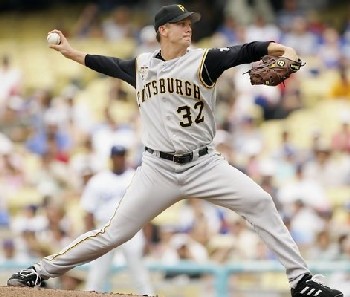
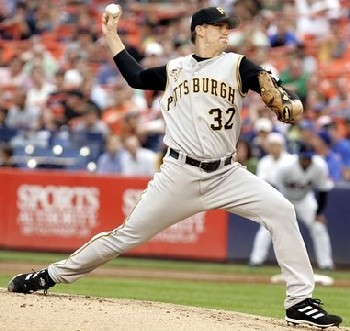
The two photos above give a sense
of Wells' mechanics and timing. As you can see, Wells has very
good timing; he gets his PAS
forearm up and into the High Cocked position before his GS foot
lands. The second photo also shows that his hips rotate ahead of
his shoulders. Notice how the line of buttons on his jersey curves
around to the right. Finally, notice that in the second photo
Wells doesn't show any signs of
Hyperabduction; his PAS elbow is just below the level of his shoulders, which
is pretty much ideal. The only thing that I don't like in the
second photo is that his forearm is slightly pronated.
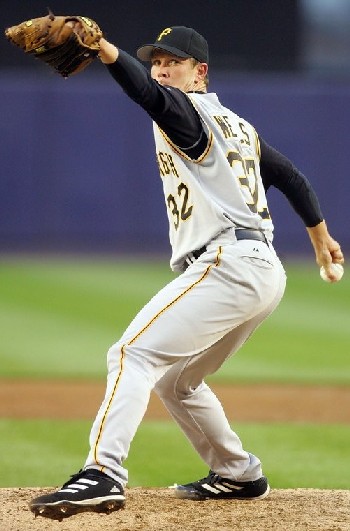
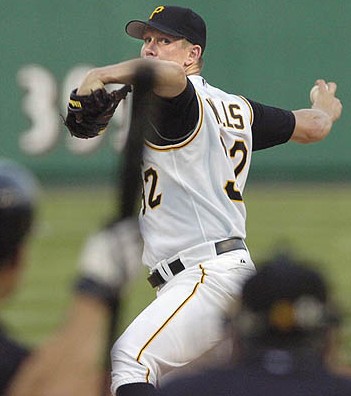
The three photos above indicate
that Wells does a good job of striding sideways to the target and
also doesn't reverse-rotate his shoulders excessively.
11/27/2006
Frame By Frame Analysis: Greg
Maddux
I have just finished
an analysis of
Greg Maddux's pitching motion and mechanics using a
number of frames from a rare video clip. I have created both
PDF and
PowerPoint
(WARNING 13MB) versions of this document. Once the document loads,
use the page up and page down buttons to go frame by frame through
the clip.
11/21/2006
Frame By Frame Analysis: Juan
Marichal
I have just finished
an analysis of
Juan Marichal's pitching motion and mechanics using a
number of frames from the clip below.

I have created both
PDF and
PowerPoint versions of this document. Once the document loads,
use the page up and page down buttons to go frame by frame through
the clip.
I'd be interested in what you think.
11/21/2006
Frame By Frame Analysis: Sandy
Koufax
I have just finished
an analysis of
Sandy Koufax's pitching motion and mechanics using a
number of frames from the clip below.

I have created both
PDF and
PowerPoint versions of this document. Once the document loads,
use the page up and page down buttons to go frame by frame through
the clip.
I'd be interested in what you think.
11/20/2006
Frame By Frame Analysis: Nolan
Ryan
Various people have criticized my method of
analyzing the mechanics of pitchers because I do it using large
numbers of still photos. As a result, I have recently put together
an analysis of Nolan Ryan's pitching motion and mechanics using a
number of frames from the clip below.

I have created both
PDF and
PowerPoint versions of this document. Once the document loads,
use the page up and page down buttons to go frame by frame through
the clip.
I am currently working on similar analyses of the mechanics
of Juan Marichal and Sandy Koufax, and will do the same for other
great pitchers, if I can find a good clip of them throwing.
I'd be interested in what you think.
11/15/2006
First Look: Daisuke Matsuzaka
Given all the hype and hubub
surrounding Japanese pitcher Daisuke Matsuzaka, I thought it would
be interesting if I took at look at his mechanics.
Before I do that, let me first mention that I think
that Matsuzaka follows Mike Marshall's ideal of throwing balls
with a lot of movement. He seems to only rarely throw a straight
ball.
Now on to the analysis.
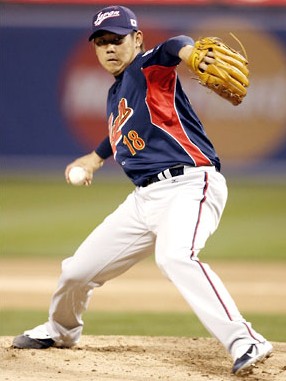
The photo above of Matsuzaka is a
textbook example of what I mean when I talk about striding
sideways with the Glove Side (aka GS) foot just skimming the
ground. Notice how he is leading with the side (really the bottom)
of his GS foot. This keeps his hips closed for as long as possible and
will allow him to pop them open just before his GS foot plants.
I
also like that he doesn't appear to show much evidence of
reverse-rotation. Instead, he's striding pretty much sideways to
the target. He's also pointing his glove and his GS upper arm just
to the right of the target, which helps to keep his shoulders
closed (facing Third Base). Striding sideways to the target,
instead of reverse-rotating, will also help him hide the ball from
the batter.
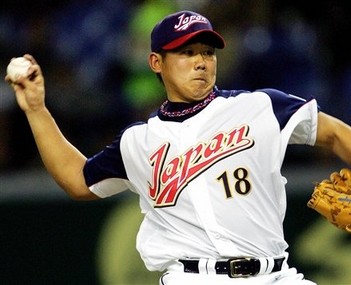
The photo above shows three things.
First it shows his hips rotating ahead of his shoulders. Notice
how his belt buckle is rotating to face the target. Second, it
shows how he holds his change-up. He uses a slightly modified
circle change-up grip. Finally, it shows that Matsuzaka doesn't
show any signs of
Hyperabduction; instead, he keeps his
PAS forearm below the level of his shoulders.
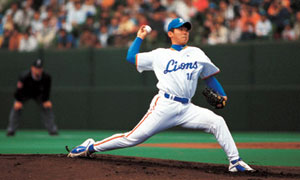
The photo above, while small,
shows several things. First, like the previous photo it shows that
his hips rotate before his shoulders. Second, it shows that
Matsuzaka has solid timing. His Pitching Arm Side (aka PAS)
forearm is vertical as his shoulders start to turn. Finally, it
also shows that Matsuzaka keeps his PAS forearm below the level of
his shoulders. This should help to protect his shoulder.
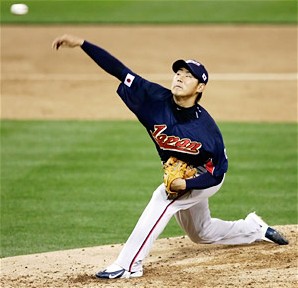
The photo above shows Matsuzaka
just after releasing the ball. While I'm not thrilled with where
his glove finishes (I wish it was a little higher up by his GS pec), he will still
finish in a solid fielding position. I also like that he maintains
some flex in his GS knee rather than locking it.
11/15/2006
A Question About Chris
Carpenter and Early Pronation
I recently received this question
from a reader about my
comments about Chris Carpenter...
I don't get it?? In your blog
post you seem to support the idea of early pronation but in
the picture of Chris Carpenter you say that his early
supination is good as it will allow him to forcefully
pronate. This will enable him to pronate his forearm as his
elbow is extending, which should help to protect his UCL. Why wouldn't early pronation here be
better?
As I explain in my piece entitled
Pronate Early (and Often), I believe that it is important that
pitchers pronate (rotate counter-clockwise) their forearms both as
their elbows are extending and through the release point. This
enables the Pronator Teres muscle take up some of the load that is
normally focused on the UCL.
For a pitcher to be able to pronate through the
extension of their elbow and the release point, their forearm must
be supinated (rotated clockwise) at the high cocked position. If
their forearm was pronated at the high cocked position (as it
would be if you were trying to show the ball to Second Base and
Center Field), then you would have to supinate your forearm to get
your palm facing the target. This would focus the load on the UCL
and cause the bones in your elbow to slam together.
If you don't understand what this is necessary, then I
suggest that you read my piece entitled
How Roger Clemens (Actually) Throws The Ball. It explains what
a pitcher's arm actually does as they throw the ball.
11/13/2006
Two Drills That I Use
I have recently gotten a number
of e-mails about the
drills that I use. As a result, I have put together two essays
that describe my
Foot Flip Drill and my
Sideways Shoulders Drill.
The
Pitching Mechanic - October 2006
|